Introduction
In the previous part we looked at in detail the function of cholesterol in the body which were:
- Cholesterol essential for cell structure
- Cholesterol is essential for brain function and health
- Cholesterol is essential for hormone production
- Cholesterol is essential for bile production from the liver
- Cholesterol is essential for Vitamin D synthesis
Another important function of cholesterol in the body is Repair.
The body uses cholesterol as a repair material for locations like arteries, veins etc that have become damaged from inflammation.
This is where it gets interesting since it is this area that has become the basis of the central dogma perpetuated to all and sundry as an excuse to sell cholesterol lowering drugs.
They have managed to turn the masses into sheep including physicians convincing them that their products are protective toward CHOLESTEROL..the secret weapon that has been unleashed by the body for the sins of humanity. Excuse me for a minute but this reminds me of a memorable sketch from Monty Python:
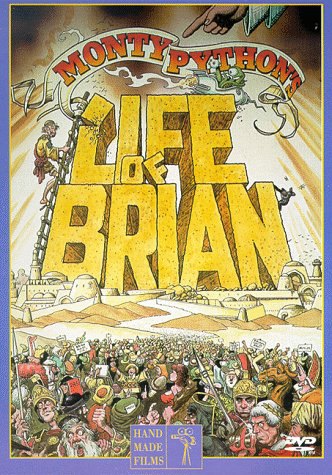
And what have they ever given us in return?!
XERXES: The aqueduct?
REG: What?
XERXES: The aqueduct.
REG: Oh. Yeah, yeah. They did give us that. Uh, that’s true. Yeah.
COMMANDO #3: And the sanitation.
LORETTA: Oh, yeah, the sanitation, Reg. Remember what the city used to be like?
REG: Yeah. All right. I’ll grant you the aqueduct and the sanitation are two things that the Romans have done.
MATTHIAS: And the roads.
REG: Well, yeah. Obviously the roads. I mean, the roads go without saying, don’t they? But apart from the sanitation, the aqueduct, and the roads–
COMMANDO: Irrigation.
XERXES: Medicine.
COMMANDOS: Huh? Heh? Huh…
COMMANDO #2: Education.
COMMANDOS: Ohh…
REG: Yeah, yeah. All right. Fair enough.
COMMANDO #1: And the wine.
COMMANDOS: Oh, yes. Yeah…
FRANCIS: Yeah. Yeah, that’s something we’d really miss, Reg, if the Romans left. Huh.
COMMANDO: Public baths.
LORETTA: And it’s safe to walk in the streets at night now, Reg.
FRANCIS: Yeah, they certainly know how to keep order. Let’s face it. They’re the only ones who could in a place like this.
COMMANDOS: Hehh, heh. Heh heh heh heh heh heh heh.
REG: All right, but apart from the sanitation, the medicine, education, wine, public order, irrigation, roads, a fresh water system, and public health, what have the Romans ever done for us?
XERXES: Brought peace.
REG: Oh. Peace? Shut up!
So we can easily substitute..what has cholesterol ever done for us.
A Brief History of the Demon called Cholesterol
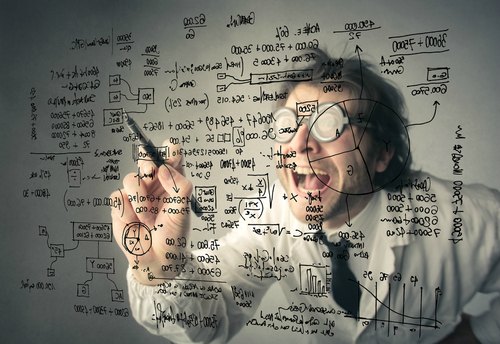
Historically (Hysterically) it was 1910 when a German chemist discovered high concentrations of cholesterol in the aortas that people who were suffering or expired from Atherosclerosis.
Moving on, when 18 year old soldiers that were killed in the Korean war (1950s) were autopsied they already showed signs of plaque buildup in their arteries.. so this cholesterol disease starts when you’re a kid..Forty years on and nobody has showed up to save us from this scourge.
Then a great white knight in 1995 called Schering-Plough created a saviour drug called Ezetimibe a cholesterol lowering drug that works on the gut by restricting cholesterol absorption from food and bile…phew..that’s a relief..I was dreading every day putting butter and fatty meat in my mouth wandering when cholesterol was going to choke my heart and in the words of Humphrey Bogart “I would be a gonna”.
Thankfully, the side effects only include muscle or joint pain, stuffy nose, diarrhea or a pain in the leg and as advertised this is not a complete list but I am sure the other side effects are minimal…I mean what could be worse than a pain in the leg..a pain in the ass??.
The drug makers (Schering-Plough & Merck) also were happy because by 2007 combined sales of Ezetimibe (brand name Zetia) and a statin called Vytorin amounted to $5 billion.
Alas at the end of a trial called ENHANCE completed in 2008 on Vytorin, the results were disappointing, hoping that the lower the LDL level the better off the heart would be, but that was not the case.
It did reduce the LDL level down to 141 from 210 but this did not translate to healthier arteries, and did not help in Aortic Stenosis (Aortic valve narrows restricting blood flow).
However, the steadfast scientists was not having any of it and they stuck to their guns and all agreed that high LDL levels is a marker for potential heart disease and statin drugs does reduce the risk of heart disease. They argued that the ENHANCE study was not long enough and relied on indirect measurements of heart disease…
So the study was terribly done because the outcome goes against all of our preconceived ideas..LOL
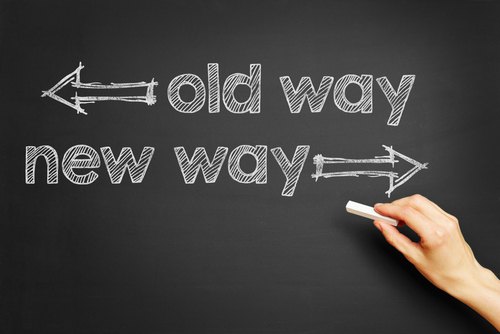
WAKE UP PEOPLE..SHED YOUR OLD THINKING!
Cholesterol Essential for Healing
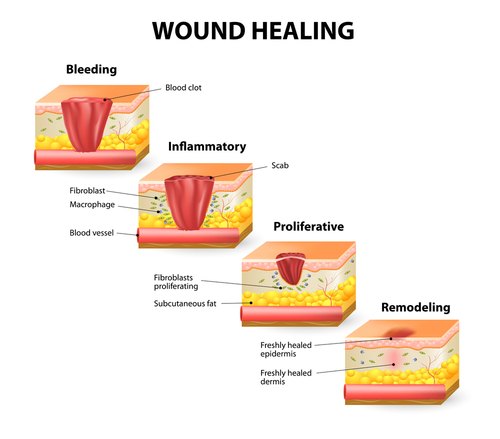
Whenever the body suffers a wound or damage caused by inflammation occurring to an artery or a vein or other tissue damage caused by surgery, the liver is notified to ship cholesterol and fats to the site.
Since lipids (fats) and cholesterol are insoluble in water it requires a special transport to ship the repair material via the bloodstream to where it is needed.
The lipid transport used is shown in the diagram 1 below:
Diagram 1: Pictorial representation of an LDL Particle (Chylomicron is similar but less protein more fat)
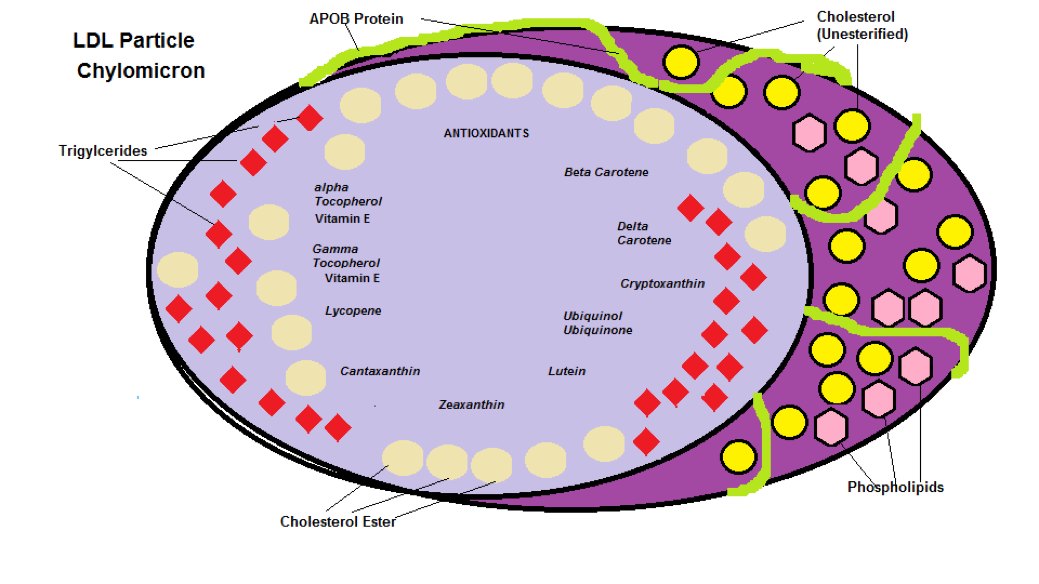
When the LDL particle reaches its destination the LDL transfers its cargo into the cell via a process called Endocytosis (there are 4 endocytosis pathways that we will not discuss here), this process also occurs during the uptake of cholesterol by intestinal epithelial cells.
Cells will only accept Unesterified cholesterol or Free cholesterol (this is the active form of cholesterol) as opposed to the storage form of cholesterol known as Esterified or cholesterol esters. (only unesterified cholesterol is absorbed from the diet, the ester form is too bulky).
The liver actually uses a distribution mechanism called the Hepatic Alpha Tocopherol Transfer Protein for distribution throughout the body via VLDL (Very Low density proteins) which get converted to LDL.
In diagram 1 the ratio between the Cholesterol esters vs. triglycerides is 4:1
The Unesterified cholesterol on the outer surface alongside the APOB Protein is there for structural purposes (to maintain integrity of the particle).
Diagram 2: Lipoprotein Distribution
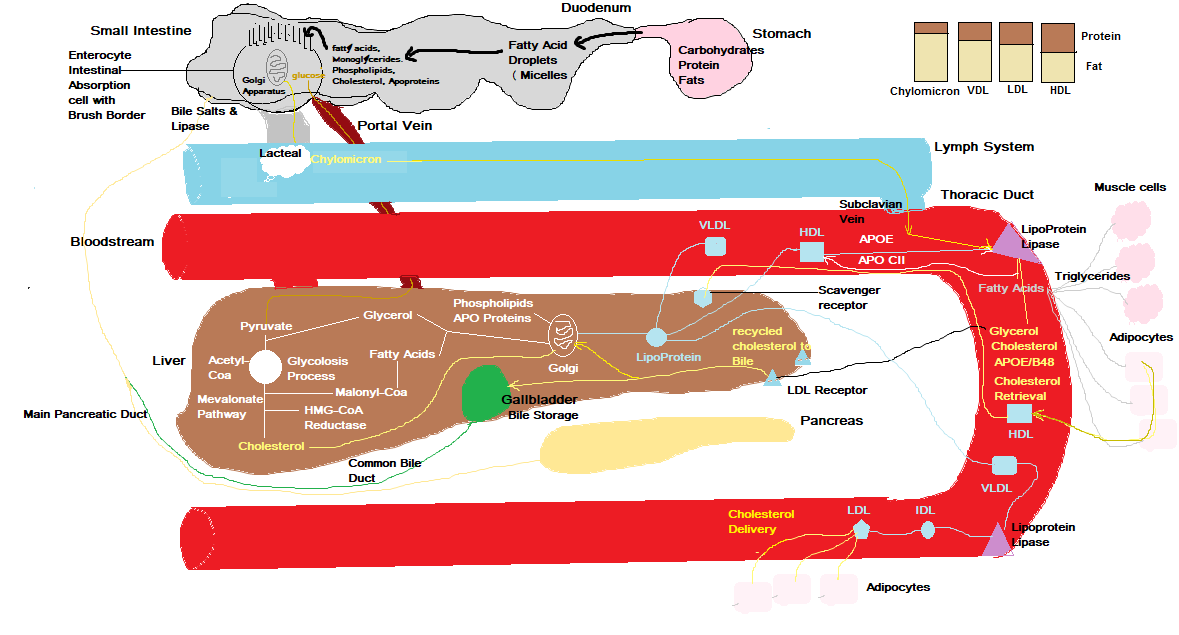
Lipid Distribution
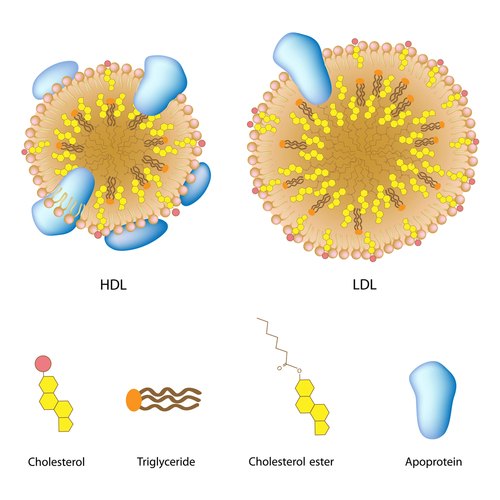
To understand Lipid distribution I would like to explain using Diagram 2 shown above.
Intestinal Epithelial Absorption
The types of lipid transports display the contents of Protein versus Fat, so the case of the chylomicron it is mostly fat and little protein whereas the HDL is half-half.
Commencing at the top of the diagram the partly digested contents of a meal empties into the duodenum (small intestine) in the form of Fatty Acid droplets called Micelles.
The various constituent parts Fatty acids, Monglycerides, Phospholipids, Fat soluble vitamins (A,D,E,K) are absorbed in the Intestinal absorptive cells (Enterocytes).
If you have read ‘The Microbiome and Disease Part 2’ you will recall that the Intestinal Epithelium gut barrier consists of Intestinal epithelial cells ( IEC) which are the Enterocytes that absorb food and nutrients.
However before absorption these various constituent parts which are basically fat globules.
In the diagram you will notice a Common Bile duct connected to the GallBladder and then junctioned with the main Pancreatic duct that feeds into the ileum part of the intestine with Bile salts (cholic, deoxycholic, chenodeoxycholic, and lithocholic acids), and Pancreatic Lipase.
The bile salts bind to the fat globules hydrophobically (non polar, repels water), so as it can get to work breaking down the fat globule without interference from the water inside the intestine.
Once the bile salts have liberated the fat globule into fatty acid droplets (Micelles), containing tryglicerides, Phospholipids, cholesterol etc, the Pancreatic Lipase binds to a protein Colipase that are on the droplets and the lipase enzymes can go to work Hydophilically ( working within a polar water environment) seperating the glycerol and the free fatty acids, by breaking the Ester bonds.
The glycerol is bound to one fatty acid called monoglycerides’
Now the seperated constituents that are the Monoglycerides, the free fatty acids, cholesterol and the fat soluble Vitamins thus producing the Micelles, which the bile salts surround repelling the intestinal water.
The Chylomicron (Dietary cholesterol transport)
Before absorption by the Enterocyte the bile salts are left behind, while the rest are packaged onto a transport using the cellular Golgi Apparatus which also adds a protein called APOB-48 and the Chylomicron is created’
The enterocyte re-esterifys the glycerol and fatty acid into Triglycerides which is then combined with Cholesterol ester, Phospholipids ( crucial for cellular membranes ) and the Apolipoprotein ( APOB-48).
When dietary fat is absorbed in the enterocytes a milky fluid is formed that consists of Lymph and emulsified fats (Free Fatty Acids), called Chyle(greek word derivative meaning Juice) , which is then scooped by Lymphatic Capilliaries called Lacteals.
The Chylomicrons(taken from the word chyle) then merge into the Lacteals that empty through the Thoracic duct into the bloodstream at the Subclavian vein (Hepatic Portal Vein) located just by the neck
Once the chylomicron has entered the bloodstream, an HDL previously produced by the liver that donates 2 proteins APOE and APB-C11 to the passing chylomicron, so now the chyomicron contains 3 proteins including APO-B48.
APO-C11 activates Lipprotein Lipase which liberates the trigylcerides into the cells and possibly dietary Unesterified cholesterol.
The Chylomicron, once unloaded approx 85% of its cargo returns the APO-CII to the HDL donor and then travels to an LDL receptor located on the liver with aid of the APOE protein.
The APO-B48 activates Heparin Suphate Proteoglycans on the livers surface to assist with Cell adhesion. The rest of the chylomicron cargo is offloaded and can be used in the bile or storage or even make up some part of a VLDL transport using another protein APB-100.
Glucose is produced using 2 sodium molecules and transported through the portal vein into the liver which, through the Glycolysis process manufactures Cholesterol (there are many more chemical intermediate steps which are not shown for clarity) using an important enzyme called HMG-Coa Reductase which is the drug target that is blocked ( or repressed ) by a cholesterol lowering agent (brand name Statins).
The liver only manufactures VLDL (Very low density lipoproteins) and HDL (High density Lipoproteins).
VLDL’s transport endogenous products whereas Chylomicrons transport exogenous or dietary products.
The Lipoprotein package is again assembled by the Golgi apparatus* this time within the Hepatocyte liver cells.
The assembly components consists of Triglycerides (formed from 3 fatty acids and Glycerol taken from the glucose input from the intestinal epithelium), Phospholipids, Apoproteins and cholesterol that is manufactured via the Mevalonate pathway via several chemical reactions of Glycolysis.
The liver packages the VLDL transport which is then converted to a smaller transport called an Intermediate density lipoprotein (IDL).
This conversion is performed by the enzyme Lipoprotein Lipase that remove the triglycerides to be used for energy or storage reducing it to a smaller IDL particle.
Furthermore, the ApoE is removed (since this 299 amino acid protein is used for the breakdown of triglycerides which have already been removed) leaving just the ApoB-100.
The ApoB-100 protein organizes the packaging and acts as a Ligand (docking site) for LDL receptors in various cells throughout the body and it is this protein that acts as tag that cells recognise and accept. thus forming an LDL particle.
The LDL particle, whose prime purpose is to deliver cholesterol around the body and once it has delivered its payload the LDL particle returns to the liver where any leftover cholesterol is either recycled through the Golgi Apparatus or excreted into the bile.
Finally the second LP made by the liver, the HDL is initially empty of cholesterol and its job is to scoop-up the unused or excess cholesterol from the body’s tissue and return it to the liver via a ‘scavenger receptor’ where again the excess cholesterol is either recycled through the Golgi Apparatus or excreted into the bile.
*Golgi Apparatus within a cell is part of the endomembrane system which are various membranes suspended in the cytoplasm. The Golgi (named after Italian scientist Camillo Golgi who discovered this structure in 1898) apparatus is made of multiple compartments where molecules are packaged together for delivery to another cell or tissue.
The Cholesterol Hypothesis-
“Here We Go Again”
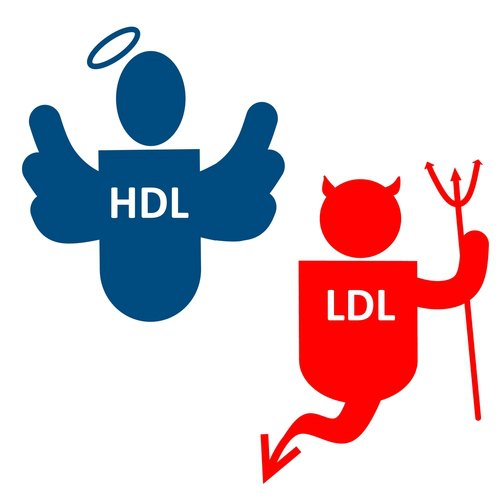
So for those very few who are not aware of this hypothesis..let me enlighten you. According to whomever they may be, most of the planet perhaps, and according to many studies..so they they say, if the LDL transport of cholesterol is ‘too high’ then there is risk of atherosclerosis and cholesterol plaques being placed in the arteries that would clog up the blood flow and cause heart attacks.
So LDL was branded as the ‘BAD’ cholesterol and the ‘GOOD’ cholesterol is the HDL particle because its scavenging for excess cholesterol and removing it from the sites that the LDL put there.
So this very simple misguided story set off a chain of events that made everybody scared of eating cholesterol and in the process made the pharmaceutical industry billions.
In fact the original tale was that if you eat too much cholesterol the cholesterol level in the blood increases and then cholesterol gets deposited on artery walls causing them to thicken and narrow.
Let us make sense of all this
First of all, if anybody would even think that the intelligence of the human body would just place ‘crud’ into an artery because you ate an essential nutrient like cholesterol should check themselves into the nearest asylum.
As James Black from his lectures on elements of chemistry of 1803 stated:
“A nice adaptation of conditions will make any hypothesis agree with the phenomena. This will please the imagination, but does not advance our knowledge”
From the previous paragraph we have learnt that dietary intake of fat is directly taken to the tissue of the body by the Chylomicron lipoprotein so eating fat or cholesterol has no association with lipid distribution in the body orchestrated by the liver, i.e LDL Cholesterol distribution.
So the target of discussion must be the VLDL (The source of LDL)..do you not agree Dr Watson?
A study that was completed and published in the American Journal of Medicine in 2004 confirmed that a low carbohydrate, high fat diet fed to obese individuals for 6 months resulted in an 11% increase in HDL and a 49% decrease in VLDL triglyceride level.
You would think therefore that this would also affect LDL levels, but as it turns out LDL actually stayed fairly constant over years despite varying VLDL rates because the body regulates cholesterol distribution depending on the need (do you all remember what I said about the allostatic paradigm for blood pressure and cholesterol levels..the body constantly adjusts cholesterol and blood pressure based on the needs of the body..crucial markers that naturally change daily).
Even the Framingham study that has been running since 1948 looking at heart disease confirmed in 1992 that the more saturated fat and cholesterol consumed in the diet the lower the cholesterol serum level (LDL).
Conclusion
From the mode of action described in the lipoprotein distribution, what happens when cholesterol manufacture is slowed down in the liver and all other cells, it soon runs out of cholesterol to make more VLDLs.
The liver responds by increasing the number of its LDL receptors to retrieve as much cholesterol as it can get, to produce more VLDLs, and as a consequence the number of LDLs diminish.
Intended result achieved and everybody’s happy..unfortunately not everybody, because as I have said before there are consequences when biological processes are tampered with.
Although cholesterol synthesis is slowed in the liver it has no effect on dietary lipids, triglycerides or cholesterol that could be damaged once packaged up in the chylomicron and delivered directly to the tissue.
However, the products that could cause inflammation, the body will attempt to repair with cholesterol..but it has very little for this purpose and all the other cholesterol requirements.
It is these consequences that we will explore in the final article on cholesterol lowering drugs.
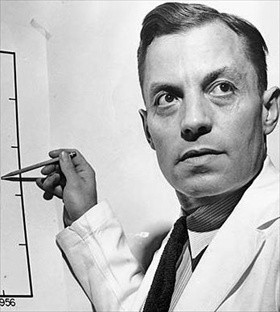
“There’s no connection whatsoever between cholesterol in food and cholesterol in blood. And we’ve known that all along. Cholesterol in the diet doesn’t matter at all unless you happen to be a chicken or a rabbit.”
Ancel Keys, PhD, Professor Emeritus at the University of Minnesota, 1997
Check out the Previous Article in this series:
https://www.extremehealthacademy.com/selling-sickness-part-1-conventional-medicine-is-a-business/
https://www.extremehealthacademy.com/selling-sickness-part-2-profits-before-health/
https://www.extremehealthacademy.com/selling-sickness-part-3-baffling-the-masses/
https://www.extremehealthacademy.com/selling-sickness-part-4-prostaglandin-drugs/
https://www.extremehealthacademy.com/convential-medicine-part-5-the-business-of-antidepressants/
https://www.extremehealthacademy.com/selling-sickness-part-6-cholesterol-lowering-drugs-part-1/
References/Acknowledgments:
- The cholesterol myth Book by George Mann MD
- The great cholesterol con Book 2008 by Dr Malcolm Kendrick
- Put your heart in your mouth Book 2014 by Natasha Campbell Mcbride
- Ezetimbe Drugs.com
- Lipoprotein,Lipase,Chylomicron, Golgi Apparatus Wikipedia
- Cholesterol veers off script Jennifer Couzin 2008 Science
- Physiology of Lipoproteins, Cholesterol, YouTube Video Armando Hasadungan
- Metabolism | Lipoprotein Metabolism | Chylomicrons, VLDL, IDL, LDL, & HDL Ninja Nerd Science 2018 Youtube
- Life of Brian script Scene 10 Before the romans things were smelly Monty python website
Author: Eric Malouin